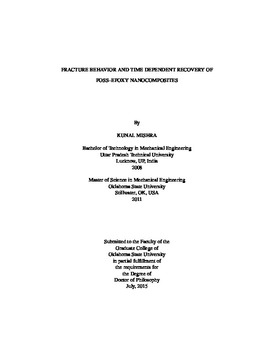| dc.contributor.advisor | Singh, Raman Pal | |
| dc.contributor.author | Mishra, Kunal | |
| dc.date.accessioned | 2016-09-29T18:41:27Z | |
| dc.date.available | 2016-09-29T18:41:27Z | |
| dc.date.issued | 2015-07 | |
| dc.identifier.uri | https://hdl.handle.net/11244/45284 | |
| dc.description.abstract | This study investigates the fundamental mechanism that governs the influence of glycidyl POSS on the time-dependent behavior of epoxy-POSS composite as a function of added weight percent. Different formulation of POSS-epoxy composites were prepared using simple mixing technique. Dynamic mechanical analysis were used to study different transition occur in polymer chain as a function of temperature. The dampening effect of POSS inclusion in epoxy resin was observed by change in Loss Modulus and tan delta. Time temperature superposition principle was applied successfully to the storage modulus and loss modulus. Master curve obtained from TTS indicated the satisfaction of quality. The resulting shift factor was correlated with a significant increase in the free volume in molecular network. Increasing POSS loading showed no sign of phase separation as derived from master curve and thermodynamic gap in CTE. Concerning viscoelastic modeling, Generalized Maxwell model was used to generate viscoelastic parameters for predictive information of nanocomposite. The model showed a good agreement between the theoretical and experimental viscoelastic properties. To further understand the rate-dependency of POSS-epoxy nanocomposite, tensile experiment at different rate were performed. Results showed that with increase in loading rate the modulus of the nanocomposite increases also change in failure mode was observed. XRD on the fractured sample was done to investigate site of deformed energy from the observation of stress-induced crystallinity. XRD spectra also showed that with increase in the loading of the POSS in the composite intensity of crystalline peaks increases. Fracture toughness of the nanocomposite was performed according to ASTM standard at cryogenic temperature. 100% increase in fracture toughness was observed in 5 wt.% POSS loading. Dynamic characterization of the POSS-epoxy nanocomposite takes place using Split Hopkinson Pressure Bar at high strain rates (400- 800 s-1). Single loading pulse of 550 ms is used to load the specimen. For comparison in strain rate, test at quasistatic rate are also performed. The test results shows that both Young's modulus and yield strength is sensitive to strain rate. Both dynamic and quasistatic experiment shows increase in the toughness with higher concentrations of POSS. | |
| dc.format | application/pdf | |
| dc.language | en_US | |
| dc.rights | Copyright is held by the author who has granted the Oklahoma State University Library the non-exclusive right to share this material in its institutional repository. Contact Digital Library Services at lib-dls@okstate.edu or 405-744-9161 for the permission policy on the use, reproduction or distribution of this material. | |
| dc.title | Fracture behavior and time dependent properties of poss-epoxy nanocomposites | |
| dc.contributor.committeeMember | Vaidyanathan, Ranji | |
| dc.contributor.committeeMember | Kalkan, A. Kaan | |
| dc.contributor.committeeMember | Harimkar, Sandip P. | |
| osu.filename | Mishra_okstate_0664D_14133.pdf | |
| osu.accesstype | Open Access | |
| dc.type.genre | Dissertation | |
| dc.type.material | Text | |
| thesis.degree.discipline | Mechanical and Aerospace Engineering | |
| thesis.degree.grantor | Oklahoma State University | |
